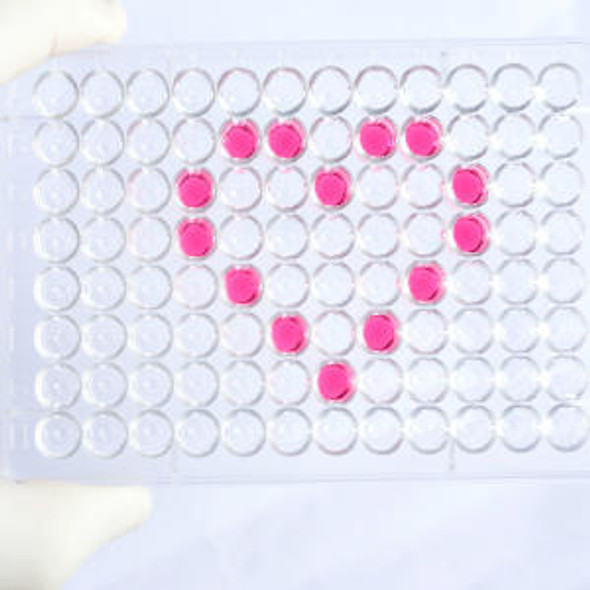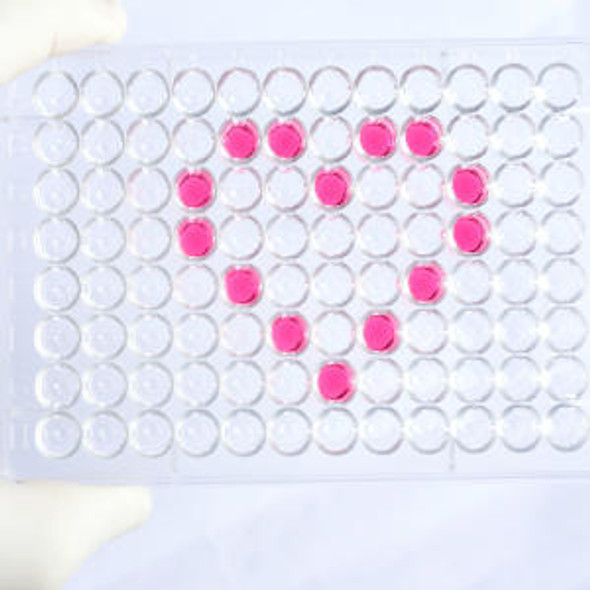Human Keratin, type I cytoskeletal 18 (KRT18) ELISA Kit (HUEB1281)
- SKU:
- HUEB1281
- Product Type:
- ELISA Kit
- Size:
- 96 Assays
- Uniprot:
- P05783
- Range:
- 62.5-4000 pg/mL
- ELISA Type:
- Sandwich
- Synonyms:
- KRT18, CK-18, CytokeRatin 18, KeRatin, type I cytoskeletal 18, KeRatin-18, K18, Cell prolifeRation-inducing gene 46 protein, CytokeRatin-18
- Reactivity:
- Human
Description
Human Keratin, type I cytoskeletal 18 (KRT18) ELISA Kit
The Human Keratin Type I Cytoskeletal 18 (KRT18) ELISA Kit is a powerful tool for researchers looking to accurately measure levels of KRT18 in human serum, plasma, and cell culture supernatants. With high sensitivity and specificity, this kit provides reliable and reproducible results for a variety of research applications.KRT18 is a critical protein involved in maintaining the structural integrity of cells, particularly in epithelial tissues. Abnormal levels of KRT18 have been associated with various diseases, including liver disease, cancer, and inflammatory disorders, making it a valuable biomarker for studying and potentially treating these conditions.
With the Human KRT18 ELISA Kit, researchers can gain valuable insights into the role of KRT18 in disease progression and develop new strategies for diagnosis and treatment. Trust in the accuracy and reliability of this kit to advance your research efforts in the field of cell biology and disease pathology.
| Product Name: | Human Keratin, type I cytoskeletal 18 (KRT18) ELISA Kit |
| SKU: | HUEB1281 |
| Size: | 96T |
| Target: | Human Keratin, type I cytoskeletal 18 (KRT18) |
| Synonyms: | Cell proliferation-inducing gene 46 protein, Cytokeratin-18, Keratin-18, CK-18, K18, PIG46, CYK18 |
| Assay Type: | Sandwich |
| Detection Method: | ELISA |
| Reactivity: | Human |
| Detection Range: | 62.5-4000pg/mL |
| Sensitivity: | 19.5pg/mL |
| Intra CV: | 4.6% | ||||||||||||||||||||
| Inter CV: | 8.0% | ||||||||||||||||||||
| Linearity: |
| ||||||||||||||||||||
| Recovery: |
| ||||||||||||||||||||
| Function: | Involved in the uptake of thrombin-antithrombin complexes by hepatic cells (By similarity). When phosphorylated, plays a role in filament reorganization. Involved in the delivery of mutated CFTR to the plasma membrane. Together with KRT8, is involved in interleukin-6 (IL-6)-mediated barrier protection. |
| Uniprot: | P05783 |
| Sample Type: | Serum, plasma, tissue homogenates, cell culture supernates and other biological fluids |
| Specificity: | Natural and recombinant human Keratin, type I cytoskeletal 18 |
| Sub Unit: | Heterotetramer of two type I and two type II keratins. KRT18 associates with KRT8. Interacts with the thrombin-antithrombin complex (By similarity). Interacts with PNN, HCV core protein and mutated CFTR. Interacts with YWHAE, YWHAH and YWHAZ only when phosphorylated. Interacts with DNAJB6, TCHP and TRADD. Interacts with FAM83H (PubMed:23902688). Interacts with EPPK1. |
| Research Area: | Epigenetics |
| Subcellular Location: | Cytoplasm Perinuclear region Nucleus Nucleolus |
| Storage: | Please see kit components below for exact storage details |
| Note: | For research use only |
| UniProt Protein Function: | K18: a type I cytoskeletal keratin. The keratins are intermediate filament proteins responsible for the structural integrity of epithelial cells and are subdivided into cytokeratins and hair keratins. Keratin 18 and its filament partner keratin 8 are perhaps the most commonly found members of the intermediate filament gene family. They are expressed in single layer epithelial tissues of the body. Defects are a cause of cryptogenic cirrhosis. |
| UniProt Protein Details: | Protein type:Nucleolus; Cytoskeletal Chromosomal Location of Human Ortholog: 12q13 Cellular Component: cytoplasm; intermediate filament; keratin filament; microtubule organizing center; nucleolus; perinuclear region of cytoplasm Molecular Function:protein binding; structural molecule activity Biological Process: anatomical structure morphogenesis; cell cycle; Golgi to plasma membrane CFTR protein transport; intermediate filament cytoskeleton organization and biogenesis; negative regulation of apoptosis; tumor necrosis factor-mediated signaling pathway; viral reproduction Disease: Cirrhosis, Familial |
| NCBI Summary: | KRT18 encodes the type I intermediate filament chain keratin 18. Keratin 18, together with its filament partner keratin 8, are perhaps the most commonly found members of the intermediate filament gene family. They are expressed in single layer epithelial tissues of the body. Mutations in this gene have been linked to cryptogenic cirrhosis. Two transcript variants encoding the same protein have been found for this gene. [provided by RefSeq, Jul 2008] |
| UniProt Code: | P05783 |
| NCBI GenInfo Identifier: | 125083 |
| NCBI Gene ID: | 3875 |
| NCBI Accession: | P05783.2 |
| UniProt Secondary Accession: | P05783,Q53G38, Q5U0N8, Q9BW26, |
| UniProt Related Accession: | P05783 |
| Molecular Weight: | |
| NCBI Full Name: | Keratin, type I cytoskeletal 18 |
| NCBI Synonym Full Names: | keratin 18 |
| NCBI Official Symbol: | KRT18 |
| NCBI Official Synonym Symbols: | K18; CK-18; CYK18 |
| NCBI Protein Information: | keratin, type I cytoskeletal 18 |
| UniProt Protein Name: | Keratin, type I cytoskeletal 18 |
| UniProt Synonym Protein Names: | Cell proliferation-inducing gene 46 protein; Cytokeratin-18; CK-18; Keratin-18; K18 |
| Protein Family: | Keratin |
| UniProt Gene Name: | KRT18 |
| UniProt Entry Name: | K1C18_HUMAN |
| Component | Quantity (96 Assays) | Storage |
| ELISA Microplate (Dismountable) | 8×12 strips | -20°C |
| Lyophilized Standard | 2 | -20°C |
| Sample Diluent | 20ml | -20°C |
| Assay Diluent A | 10mL | -20°C |
| Assay Diluent B | 10mL | -20°C |
| Detection Reagent A | 120µL | -20°C |
| Detection Reagent B | 120µL | -20°C |
| Wash Buffer | 30mL | 4°C |
| Substrate | 10mL | 4°C |
| Stop Solution | 10mL | 4°C |
| Plate Sealer | 5 | - |
Other materials and equipment required:
- Microplate reader with 450 nm wavelength filter
- Multichannel Pipette, Pipette, microcentrifuge tubes and disposable pipette tips
- Incubator
- Deionized or distilled water
- Absorbent paper
- Buffer resevoir
*Note: The below protocol is a sample protocol. Protocols are specific to each batch/lot. For the correct instructions please follow the protocol included in your kit.
Allow all reagents to reach room temperature (Please do not dissolve the reagents at 37°C directly). All the reagents should be mixed thoroughly by gently swirling before pipetting. Avoid foaming. Keep appropriate numbers of strips for 1 experiment and remove extra strips from microtiter plate. Removed strips should be resealed and stored at -20°C until the kits expiry date. Prepare all reagents, working standards and samples as directed in the previous sections. Please predict the concentration before assaying. If values for these are not within the range of the standard curve, users must determine the optimal sample dilutions for their experiments. We recommend running all samples in duplicate.
| Step | |
| 1. | Add Sample: Add 100µL of Standard, Blank, or Sample per well. The blank well is added with Sample diluent. Solutions are added to the bottom of micro ELISA plate well, avoid inside wall touching and foaming as possible. Mix it gently. Cover the plate with sealer we provided. Incubate for 120 minutes at 37°C. |
| 2. | Remove the liquid from each well, don't wash. Add 100µL of Detection Reagent A working solution to each well. Cover with the Plate sealer. Gently tap the plate to ensure thorough mixing. Incubate for 1 hour at 37°C. Note: if Detection Reagent A appears cloudy warm to room temperature until solution is uniform. |
| 3. | Aspirate each well and wash, repeating the process three times. Wash by filling each well with Wash Buffer (approximately 400µL) (a squirt bottle, multi-channel pipette,manifold dispenser or automated washer are needed). Complete removal of liquid at each step is essential. After the last wash, completely remove remaining Wash Buffer by aspirating or decanting. Invert the plate and pat it against thick clean absorbent paper. |
| 4. | Add 100µL of Detection Reagent B working solution to each well. Cover with the Plate sealer. Incubate for 60 minutes at 37°C. |
| 5. | Repeat the wash process for five times as conducted in step 3. |
| 6. | Add 90µL of Substrate Solution to each well. Cover with a new Plate sealer and incubate for 10-20 minutes at 37°C. Protect the plate from light. The reaction time can be shortened or extended according to the actual color change, but this should not exceed more than 30 minutes. When apparent gradient appears in standard wells, user should terminatethe reaction. |
| 7. | Add 50µL of Stop Solution to each well. If color change does not appear uniform, gently tap the plate to ensure thorough mixing. |
| 8. | Determine the optical density (OD value) of each well at once, using a micro-plate reader set to 450 nm. User should open the micro-plate reader in advance, preheat the instrument, and set the testing parameters. |
| 9. | After experiment, store all reagents according to the specified storage temperature respectively until their expiry. |
When carrying out an ELISA assay it is important to prepare your samples in order to achieve the best possible results. Below we have a list of procedures for the preparation of samples for different sample types.
| Sample Type | Protocol |
| Serum | If using serum separator tubes, allow samples to clot for 30 minutes at room temperature. Centrifuge for 10 minutes at 1,000x g. Collect the serum fraction and assay promptly or aliquot and store the samples at -80°C. Avoid multiple freeze-thaw cycles. If serum separator tubes are not being used, allow samples to clot overnight at 2-8°C. Centrifuge for 10 minutes at 1,000x g. Remove serum and assay promptly or aliquot and store the samples at -80°C. Avoid multiple freeze-thaw cycles. |
| Plasma | Collect plasma using EDTA or heparin as an anticoagulant. Centrifuge samples at 4°C for 15 mins at 1000 × g within 30 mins of collection. Collect the plasma fraction and assay promptly or aliquot and store the samples at -80°C. Avoid multiple freeze-thaw cycles. Note: Over haemolysed samples are not suitable for use with this kit. |
| Urine & Cerebrospinal Fluid | Collect the urine (mid-stream) in a sterile container, centrifuge for 20 mins at 2000-3000 rpm. Remove supernatant and assay immediately. If any precipitation is detected, repeat the centrifugation step. A similar protocol can be used for cerebrospinal fluid. |
| Cell culture supernatant | Collect the cell culture media by pipette, followed by centrifugation at 4°C for 20 mins at 1500 rpm. Collect the clear supernatant and assay immediately. |
| Cell lysates | Solubilize cells in lysis buffer and allow to sit on ice for 30 minutes. Centrifuge tubes at 14,000 x g for 5 minutes to remove insoluble material. Aliquot the supernatant into a new tube and discard the remaining whole cell extract. Quantify total protein concentration using a total protein assay. Assay immediately or aliquot and store at ≤ -20 °C. |
| Tissue homogenates | The preparation of tissue homogenates will vary depending upon tissue type. Rinse tissue with 1X PBS to remove excess blood & homogenize in 20ml of 1X PBS (including protease inhibitors) and store overnight at ≤ -20°C. Two freeze-thaw cycles are required to break the cell membranes. To further disrupt the cell membranes you can sonicate the samples. Centrifuge homogenates for 5 mins at 5000xg. Remove the supernatant and assay immediately or aliquot and store at -20°C or -80°C. |
| Tissue lysates | Rinse tissue with PBS, cut into 1-2 mm pieces, and homogenize with a tissue homogenizer in PBS. Add an equal volume of RIPA buffer containing protease inhibitors and lyse tissues at room temperature for 30 minutes with gentle agitation. Centrifuge to remove debris. Quantify total protein concentration using a total protein assay. Assay immediately or aliquot and store at ≤ -20 °C. |
| Breast Milk | Collect milk samples and centrifuge at 10,000 x g for 60 min at 4°C. Aliquot the supernatant and assay. For long term use, store samples at -80°C. Minimize freeze/thaw cycles. |










